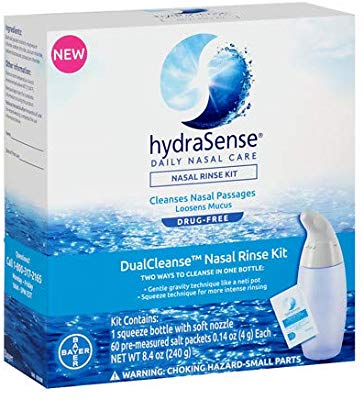Table salt contains additional unwanted ingredients.
What is neti-salt?
First link to vendor appearing in a websearch selling overpriced salt says:
Ingredients: Pharmaceutical grade sodium chloride (99.99%) USP.
Directions: Place a heaping 1/4 teaspoon in your Neti Pot and add warm water.
That is not to say that vendors opting for the name 'neti' aren't willing to also add 'exotic' stuff, that's then not beneficial either.
Regular kitchen table salt can be used but will cause problems because of all the additives.
Apart from possible unknown adulterations when using "funny" salts ('Himalaya' etc) just the usually allowed anti-caking agents for example are:
341 tricalcium phosphate
460(ii) powdered cellulose
470b magnesium stearate
500 sodium bicarbonate
535 sodium ferrocyanide
536 potassium ferrocyanide
538 calcium ferrocyanide
542 bone phosphate (i.e. Calcium phosphate)
550 sodium silicate
551 silicon dioxide
552 calcium silicate
553a magnesium trisilicate
553b talcum powder
554 sodium aluminosilicate
555 potassium aluminium silicate
556 calcium aluminosilicate
558 bentonite
559 aluminium silicate
570 stearic acid
900 polydimethylsiloxane
Some of these are listed in the Eu as E170, E504, E535, E536, E551, E559…
Table salt
Table salt is sodium chloride combined with iodine sources (for nutrition), stabilizers for the iodine, and anti-caking compounds to make it pour by preventing it from absorbing water from the air.
So supermarket bought regular table salt can be quite a bit too irritating for a nasal irrigation. Depending on jurisdiction not all ingredients have to be listed on table salt.
Nasal irrigation is based on warm saline solution, i.e. salt dissolved in lukewarm tap water. ... However, chemical anti-caking (aka “free-flowing”) additives used in common table salt (e.g. sodium silicoaluminate) produce an unpleasant burning sensation in the nose and are not advised medically or by Yoga instructors.
–– The problems of salt for neti - NetiNext
anti-caking agents or preservatives (these can be irritating to the nasal lining)
–– SALINE SINUS RINSE RECIPE 2019 American Academy of Allergy, Asthma & Immunology.
With just a little chemistry knowledge anyone can conclude: among other things nasal irrigation is used for reducing mucus viscosity. This is clearly not an outcome achieved if adding bentonite into a solution for the nasal cavity. While listed as non-toxic non-irritating, bentonite is used as cat litter, and hence it does in the nose what it does in the litter box: increases viscosity of mucus. This effect is there for all anti-caking agents. Some are directly irritating the membranes, all are doing the opposite of what one wants to achieve.
For the US salt for use in organic products:
Common anti-caking/free-flow agents that are allowed in the US table salt include:
• Calcium silicate
• Ferric ammonium citrate
• Sodium ferrocyanide
• Magnesium silicate
• Magnesium carbonate
• Propylene glycol
• Aluminum calcium silicate
• Sodium aluminosilicate
USDA organic regulations (PDF)
Ordinary table salts may still contain (sodium and magnesium carbonate (E 500, E 504), sodium-, potassium- and calcium ferrocyanides (E 535, E 536, E 538), silicon dioxide, calcium- and magnesium silicates (E 551 – E 553), iron tartrate (E 534). Aluminium salts are officially no longer allowed in Europe as an additive, but can be a found in some salts.
Additives List, E numbers in Numerical Order, Food Safety of Ireland, 2019.
Main sources for bacterial contamination are neither the salts nor the water. Preparing a too large portion of solution in advance and letting it sit, and the pots used themselves are:
Although common and frequently based on potentially dangerous bacteria, contamination is considered a false problem by some experts. They think that the nasal cavity is naturally full of bacteria and the addition of new pathogens is not clinically relevant.
The problem of sterility of the solutions and devices has been debated.
Solutions are at risk of contamination when large volumes of solution based on distilled water, bottled water, or boiled water are prepared at home, maintained in containers and used each time when NI is needed by withdrawing the required amount of liquid. Devices can be contaminated when they are continuously used without adequate cleaning. Lee et al. reported that after one and two weeks of use, irrigation bottles used by adults undergoing endoscopic sinus surgery that were washed with hot soapy water after each use were found to be contaminated by a large spectrum of bacteria, including Pseudomonas aeruginosa, Serratia marcescens, Proteus mirabilis, and Staphylococcus aureus. Similar findings were reported by other authors and, because in many cases contaminating bacteria were the same as those that could cause acute rhinosinusitis, it was suggested that the main source of device colonization was the sinonasal cavities. The risk of contamination seems independent of the type of device. Additionally, the use of a one-way valve irrigation bottle, theoretically capable of reducing the risk of reflux of contaminated solution in the device, was found to be practically ineffective. In contrast, contamination seems to be influenced by the composition of the solution. It was shown that acidic, isotonic saline solutions were more frequently associated with bacterial contamination probably because some of the most common contaminants grow optimally in similar environmental conditions. Finally, contamination was found more frequently with longer durations of NI use. With some exceptions, studies have reported that both bottles and bulb syringes were contaminated after one to two weeks of use in approximately 25% of the cases and in 45% after four weeks.
–– Nicola Principi & Susanna Esposito: "Nasal Irrigation: An Imprecisely Defined Medical Procedure", Int J Environ Res Public Health. 2017 May; 14(5): 516. doi: 10.3390/ijerph14050516 PMCID: PMC5451967
PMID: 28492494
